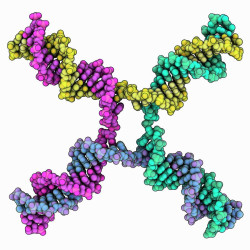By Ellie Cawthera
October 19, 2022
Time to read: 3 minutes

Researchers from the MRC London Institute of Medical Sciences (LMS), Imperial College London, the Francis Crick Institute and the University of Dundee have discovered how enzymes help tidy up DNA crossroads during genetic recombination – a key process in genome maintenance and reproduction.
Scientists from the LMS Single Molecule Imaging group, led by Professor David Rueda, tracked a single enzyme known as an endonuclease moving along a DNA molecule to see how it finds and resolves DNA crossroads known as Holliday junctions. Resolution of a Holliday junction is a key stage in genetic recombination where a DNA crossroads needs to be cut to form two separate DNA molecules. The team used optical tweezers to manipulate individual DNA molecules and fluorescence microscopy to track the endonuclease in real-time.
“Genetic recombination is a critical process in genome maintenance, meiosis and even virology,” explains David. “It’s been studied in great detail, but a missing part of the puzzle was how Holliday junctions are resolved, specifically how endonucleases know where Holliday junctions are in a vast mass of DNA. It’s like trying to find a needle in a haystack.”
Video caption: A single DNA molecule is held in place and an endonuclease travels along it until it encounters a Holliday junction in the centre where it cuts the DNA to form two separate DNA strands.
Holliday junctions are DNA crossroads that are formed when two DNA strands come together and swap sections. They are an intermediary stage of genetic recombination. The team observed that the endonucleases bind to DNA far from the target, and then rapidly move along a strand until they encounter a Holliday junction. Only when the target junction is located does the enzyme cut the DNA to resolve it into two separate strands.
The team was also able to show which part of the endonuclease enabled it to move along the DNA by observing that a version modified in a certain area was unable to do so.
“These findings are important because Holliday junction resolving enzymes can be targets for therapeutic intervention, particularly against cancer. Since resolving Holliday Junctions is crucial for cell division, understanding how to prevent their resolution in cells will help up develop new strategies against cancer. Similarly, targeted disruption of genetic recombination has potential to stop cancer cells from replicating.”
This study was published in Nature Communications on 7 October 2022.